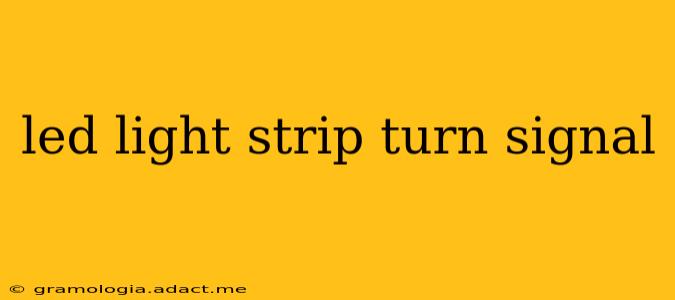Adding LED light strip turn signals to your vehicle is a popular modification, offering a modern and stylish upgrade to your car's aesthetics and safety. This comprehensive guide will cover everything you need to know about installing and using these dynamic lighting systems. We'll explore the benefits, installation considerations, legal implications, and address frequently asked questions.
What are LED Light Strip Turn Signals?
LED light strip turn signals replace traditional incandescent or LED bulb-based turn signals with flexible strips of LEDs. These strips can be integrated into various locations on your vehicle, including the front and rear bumpers, side skirts, or even integrated into custom fabricated lighting fixtures. They often feature dynamic sequential flashing patterns, offering a sleek, modern look compared to the standard single-flash system.
Benefits of Using LED Light Strip Turn Signals
- Enhanced Visibility: The increased surface area of the LED strips provides significantly improved visibility compared to traditional turn signals, enhancing safety, especially at night or in poor weather conditions.
- Modern Aesthetics: The dynamic flashing patterns and sleek design of LED light strips significantly improve the vehicle's appearance, giving it a contemporary and customized look.
- Durability: LEDs are known for their longevity and resistance to vibrations, ensuring a long lifespan for your turn signals.
- Energy Efficiency: LEDs consume less energy than traditional incandescent bulbs, leading to potential fuel savings over time.
Are LED Light Strip Turn Signals Legal?
This is a crucial question. Legality varies greatly depending on your location and specific vehicle regulations. In many jurisdictions, aftermarket modifications to turn signals must meet certain minimum brightness and flashing rate requirements to ensure adequate visibility. Always check your local Department of Motor Vehicles (DMV) or equivalent transportation authority's regulations before installing any aftermarket lighting modifications. Using non-compliant turn signals can lead to fines or even failure of vehicle inspection.
What are the legal requirements for turn signals?
Legal requirements for turn signals are location-specific. Generally, they include:
- Minimum brightness levels: Your lights must be bright enough to be seen from a considerable distance.
- Flashing rate: The flashing speed must fall within a specific range (typically 60-120 flashes per minute).
- Color: Front turn signals are usually amber (or yellow); rear turn signals are amber.
- Placement: Turn signals must be positioned in locations specified by regulations. Incorrect placement can render them illegal.
Can I use LED light strips as daytime running lights (DRLs)?
While some LED light strips might be bright enough, using them solely as DRLs is generally not recommended and likely illegal without proper certification for this specific use. DRLs have their own specific requirements regarding brightness, color, and placement.
How to Install LED Light Strip Turn Signals
Installation varies depending on the specific kit and vehicle. Generally, it involves:
- Disconnecting the battery: Always disconnect the car battery before beginning any electrical work to prevent shorts or injury.
- Routing the wiring: Carefully route the wiring to the desired location, often behind trim panels or under the vehicle's bodywork. Use cable ties to secure the wires and prevent them from moving.
- Connecting the wires: Connect the LED strip's wiring to the vehicle's turn signal circuit. This typically involves splicing into existing wiring harnesses. Improper wiring can damage your vehicle’s electrical system, so careful attention to detail and potentially professional help is crucial.
- Testing the lights: Before reassembling anything, test the lights thoroughly to ensure they function correctly and meet legal requirements for brightness and flash rate.
- Securing the strips: Once everything works, securely attach the light strips to the vehicle’s bodywork. Consider using appropriate adhesive or fasteners.
Frequently Asked Questions (FAQs)
How long do LED light strip turn signals last?
LEDs are significantly more durable than incandescent bulbs, often lasting for many years. The lifespan depends on several factors, including the quality of the LEDs and the operating environment.
Are LED light strip turn signals waterproof?
Most high-quality kits are designed to be waterproof, but it's essential to check the specifications and consider environmental factors. Improper installation can compromise waterproofing.
Can I install LED light strip turn signals myself?
While technically feasible for someone with electrical and automotive experience, installing LED light strips can be challenging. If you're not comfortable with automotive electrical work, it's recommended to seek professional help from a qualified mechanic or installer.
This guide provides a general overview. Remember to always prioritize safety and consult your local regulations and professional installers for specific guidance. The proper installation of LED light strip turn signals will dramatically improve your vehicle's appearance and safety – but only if done correctly and legally.
